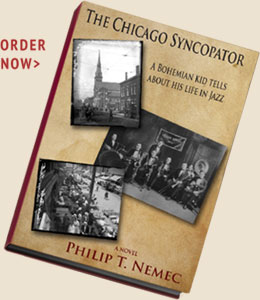The Shape of Crete
Set on the Greek island of Crete, The Shape of Crete is a thrilling drama and passionate love story between a Bulgarian artist, Steffi, and James, an American historian. Rekindling their romance after a separation, Crete’s history of ancient myths and Nazi occupation entwines them in surprise and danger. They meet an Englishman searching for traces of his brother missing since 1943, and a local woman whose father was a partisan war leader; and then, shards of information reveal Steffi’s grandfather fought with the Nazis. Danger lurks when a local thug decides Steffi and Jim’s relationships with the others concerns gold lost in the war. The final tension-driven scenes unfold in a labyrinth-like cave in the spirit of the mythical battle between Theseus and the Minotaur. The unexpected conclusion questions whether love’s best outcome is enlightenment or physical survival.
THE CHICAGO SYNCOPATOR
A Bohemian Kid Tells About
His Life in Jazz
Set in Chicago’s Czech neighborhoods in the first half of the Twentieth Century, The Chicago Syncopator, by author Philip T. Nemec, is the story of the fictional character, George Nepras, and his life in jazz. George uses his faith in his calling as a jazz musician to battle against his own limitations, cruel fates, and the myopia of his ethnic Czech community. Ultimately, he believes he has succeeded against the odds to become a success. For him, jazz is a metaphor for grace, enlivening him with an intrepid spirit, perseverance, and generous heart. George declares his story to be a testament dedicated to future generations of jazz musicians.
George tells his own story with an introduction and edits of a journalist, Charles Svoboda, whose assistance George has sought in the belief that Svoboda’s Czech heritage will make him sympathetic. In fact, Svoboda is reluctant to help until George mysteriously disappears after he drops off his savings and his hand-written manuscript wrapped in white bakery paper to Svoboda’s newspaper office. Svoboda becomes entangled in George’s narrative and comes to believe he has a moral obligation to edit and footnote the manuscript in the hopes of publishing it.
The novel is a journey through the early history of jazz as black musicians moved the music up the Mississippi from New Orleans to Chicago, and it is also a history of the great migration of Czechs to Chicago. In it, the reader is given a glimpse of how Czechs adapted to their new land. Covering the first five decades of the century, those histories also intersect with tumultuous events in Chicago including labor unrest, the flu pandemic, racial violence, war, and The Great Depression. George is caught in two worlds, one musical in which racial lines are blurred, and the other, infected with virulent racial animosity. Above all, the curtain is pulled aside so that the reader can experience the city’s love affair with jazz in the speakeasies of the “Roaring Twenties.” George befriends many of the early great musicians and in particular, one of the first white jazz legends, Bix Beiderbecke.
The Chicago Syncopator is reminiscent of James T. Farrell’s Studs Lonigan in the way it explores a young man’s survival in the rough muscularity of Chicago’s early Twentieth Century ethnic neighborhoods. George Nepras has the indomitable spirit of the quiet hero who struggles against the odds and remains a good man much in the spirit of Santiago in Hemingway’s The Old Man and the Sea.





